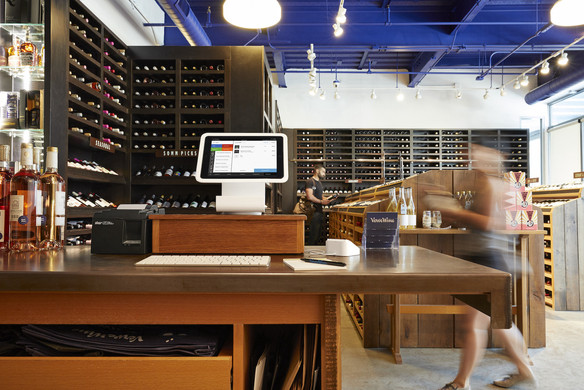Table of contents
You might have heard that brick-and-mortar retail is doomed, and that consumers only want to shop online. Neither is true. Instead, people want it both ways. Enter omnichannel retail, which has emerged as a successful sales strategy, engaging consumers from multiple fronts and enabling a seamless shopping experience.
According to a report from IDC Retail Insights, businesses who employ an omnichannel strategy report a 15 percent to 35 percent increase in average transaction size, plus a 30 percent higher lifetime value than those who shop using only one channel. But before you can enjoy the benefits of an omnichannel retail, you first need to understand how to create a strategy. Here’s how to get started:
What is omnichannel retailing?
Omnichannel retailing is an integrated approach to selling that enables customers to browse, shop, and purchase through a variety of channels, such as brick-and-mortar store, social media, website, and mobile.
Consider this example of an omnichannel retail strategy for a product sold nationwide. A customer may first notice the product in an advertisement while browsing social media. After seeing a targeted advertisement a couple of times, they click through to learn more about the product and brand. Then, when visiting a local shopping center, they see the item on an endcap, pick it up, and consider a purchase. It’s only after they get home that they pull the trigger, making a purchase on the website. That’s a clear omnichannel shopping and buying experience.
Before the web and mobile shopping, customers had limited options to shop around and plan for a purchase. These days, they may interact with your brand through their favorite social media website, read about the business on your company blog, or watch a YouTube video about your product before making a purchase decision. With an omnichannel marketing plan, business owners and managers don’t look at each sales channel in a vacuum. They look at how each opportunity to purchase may overlap and lead to a single, united customer experience.
Square recently released a new report on Omnichannel Commerce, which found that loyalty programs, social media, and coupon discounts all play a significant role in building loyalty and repeat sales. According to the results, most customers rely on Facebook and Instagram for shopping, even ahead of Google. Putting your product in front of the right audience in the right place at the right time is critical for omnichannel retail success.
You might have also heard of multichannel retailing. This can entail the same channels, but it lacks the integration of an omnichannel approach. A multichannel brand can have both a website and a brick-and-mortar store. But when customers buy items on the website, they can only return through the website, not the store — and vice versa.
The difference between omnichannel and multichannel is that omnichannel is a holistic, integrated strategy while multichannel is siloed.
Consumer behaviors are pushing the move to omnichannel
As the retail landscape has changed, so have consumer behaviors. Now, consumers have come to “expect a consistent, uniform, and integrated service or experience, regardless of the channel they use,” according to research cited in the journal Frontiers in Psychology. According to this research, consumers are always in at least one channel, and they want to use their mobile devices to search for and research items, compare prices, seek advice, and to generally gain more control over the purchase process.
In a study by the Harvard Business Review, researchers found that consumers made frequent use of a retailer’s various touchpoints. They like checking prices on an app, using in-store digital tools like tablets, and buying online and picking up in store. The research also found that, the more channels a shopper used, the more money they spent.
3 ways omnichannel elevates your retail business
1. Expands access.
Perhaps the most important way that omnichannel retail benefits your business is by offering consumers more opportunities to buy your products and services. If you are strictly a brick-and-mortar store, customers can only shop certain days and times of the week. They also have to be close enough to easily visit your business in person.
But if you offered an e-commerce option, customers could shop from anywhere, and at any time of day or night. They could also search online to check products and prices before making the trip to your store. This is something they might not have been as willing to do before knowing what you had in stock.
2. Reaches potential new customers.
In-person events are a great way to introduce your business to a wider audience. They are also a great way to create a more personal connection with previous customers. Consider speaking on a panel, offering a class, or organizing a meetup. Anything that gets you in front of people and making connections helps make an impression on potential customers and raises awareness of your business.
3. Creates a seamless experience.
An important benefit of an omnichannel strategy is that it can remove some of the hassles of the in-store shopping experience. Searching the aisles for a product or waiting in long lines to pay can be a pain. Options like buying online and picking up in store, or buying online and returning in store are customer-friendly practices that integrate the online and offline experience.
3 challenges that come from omnichannel retailing
1. Technology integration.
A truly integrated omnichannel experience should feel seamless and effortless to customers. But there is a lot of work that goes into making it seem so simple. Syncing your inventory, providing excellent customer service, and offering competitive shipping options are all challenging aspects of the omnichannel strategy for retailers.
2. Cultural barriers.
If you operate a traditional brick-and-mortar store, you might face resistance from employees when transitioning to an omnichannel approach. For example, if staffers work on commission, they might see the ecommerce side of the business as competition. That might lead them to pressure customers to buy a product that’s available in-store, instead of suggesting more suitable options that are available online.
3. Personalization.
It might sound counterintuitive, but the more channels a customer has, the easier it can be for them to slip through the cracks. It’s important that retailers create a personalized, curated shopping experience. This is a good way to win customer loyalty.
3 examples of omnichannel retail
Major retailers are leading the charge when it comes to omnichannel shopping, implementing services and loyalty programs that improve the customer experience by seamlessly integrating multiple channels. Here are a few examples:
Starbucks
The coffee chain is known for its massive brick-and-mortar presence. But despite the number of stores, customers can still face long lines and crowds. The company addressed that issue by introducing a feature on their app that allows customers to order a drink through their mobile device and then pick it up at the counter in their local store, all while earning rewrd points. This allows them to skip the line, save time, and feel incentivized to come back.
Nordstrom
Department stores are often considered the dinosaurs of the retail world. But Nordstrom has managed to stay relevant by adopting an omnichannel approach, like adding shoppable content to their Instagram posts. On posts with a tiny shopping bag icon in the top right corner, consumers can tap on the image to see which products are for sale. When they tap the desired product, it directs them to the Nordstrom website, where they can order online or buy and pick up at a local store.
Best Buy
The electronics retailer started off as a purely brick-and-mortar enterprise, but it has managed to set itself apart from its competitors by offering a robust omnichannel experience. Best Buy offers a search filter that allows customers to search for items that are available for pickup the same day, which enables them to quickly get what they want — even faster than the quickest shipping option.
Creating an omnichannel retail strategy
Every business’s omnichannel retail strategy is a bit different, so take the time to think about your goals, resources, and company culture when creating one of your own.
Long before COVID-19 hit the headlines, consumer shopping preferences were already in flux, with a general trend toward online retail shopping. The pandemic only accelerated those shifts, complicating marketing and sales efforts. As buying choices evolve, omnichannel retail will remain an important focus area for small businesses and large enterprises alike.
Consider each channel.
From brick-and-mortar to desktop to mobile to social, think about the functionality that you are equipped to offer.
- Do you want to offer shoppable Instagram posts, like Nordstrom?
- Order online and pick up in-store like Best Buy?
Think about what you are equipped to offer and perhaps roll out new experiences gradually so that you are prepared to provide customers with a seamless experience. If you roll out too quickly and disappoint customers with subpar service, it can be difficult to win back their trust.
Align inventory and experience.
How do your ecommerce channels look? Do they match the design and tone of your brick-and-mortar store? You want to make sure that your online channels closely mirror the in-store experience. One of the trickiest parts of omnichannel retail is syncing up inventory across channels so that employees and customers have an accurate sense of what is available and how they can get it.
Get employees on board.
When you’re rolling out an omnichannel strategy, it’s key that you train your staff on how to create a seamless experience. Educate them on how to use various channels to provide the best customer experience possible. If employees work on commission, consider incentivizing them when they help customers find something online that isn’t available in-store. This can help them embrace ecommerce and not see it as the enemy.
Make personalization a priority.
Don’t let customers get lost in your omnichannel retail strategy. Use customer data like previous purchases to create a unique experience. Suggest products they might like, alert them to sales at their local store, and offer them a discount when they haven’t shopped for a while. After all, customers are the heart of your business, so make sure that your focus on omnichannel makes their experience even better.
The future of omnichannel in retail
As online technologies and consumer preferences evolve, it’s crucial to maintain a forward-looking marketing and sales plan. Aware that some of the most popular social media platforms didn’t yet exist ten and twenty years ago, keen business owners and managers keep an eye on new retail developments.
The Square Omnichannel Commerce Report found essential insights into customer loyalty and repeat business, a trend that’s likely here to stay. For example, customers who enroll in Square Loyalty rewards are twice as likely to be repeat customers and spend 37% more on average. Those who open a coupon spend almost 60% more than those not enrolled in marketing programs.
These results clearly show that customers are open to engagement with a wide range of brands, including small and locally owned businesses.
When shopping, a customer might drop in to browse and make a final purchase decision online. Facebook, Instagram, and Google were the top three sites visited for shopping with Square.
When it comes to fulfillment, customer preferences are shifting away from in-person pickup. In fact, 60% of customers prefer receiving an item through a shipping service, making it more popular than pickup or delivery.
The end-to-end omnichannel shopping experience may involve discovering a product or service on social media, visiting a retail store without making a purchase, and finally completing the sale online, expecting quick delivery through a major shipping company. With so many potential customer touchpoints and a possibly lengthy sales cycle, it’s easy to see why omnichannel retail is the future of retail.
![]()














